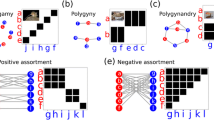Abstract
In order to provide inferential support to the MI measure of sexual dimorphism we proposed for populations distributed as mixture models with two normal components, an interval estimate is constructed. There do not appear to exist measures of sexual dimorphism that possess inferential properties other than some statistics used with this purpose. The use of these sample functions in such a context as well as the purported inferential support of some other sexual dimorphism indices are discussed. A biological case study illustrates the distinct inferential conclusions that can be obtained when the indices here discussed and the one we proposed are considered.
Similar content being viewed by others
References
Chakraborty, R. and P. P. Majumder (1982). On Bennett’s measure of sex dimorphism. Am. J. Phys. Anthropol. 59, 295–298.
Dempster, A. P., N. M. Laird and D. B. Rubin (1977). Maximum likelihood from incomplete data via the EM algorithm. J. R. Stat. Soc. B 39, 1–38.
Diebolt, J. and C. P. Robert (1990). Estimation of finite mixture distributions through Bayesian sampling (parts I and II). Rapports Techniques 109, 110, LSTA, Université Paris 6.
Fieller, E. C. (1954). Some problems in interval estimation. J. R. Stat. Soc. B 16, 175–185.
Greene, D. L. (1989). Comparison of t-tests for differences in sexual dimorphism between populations. Am. J. Phys. Anthropol. 79, 121–125.
Hahn, G. J. and W. Q. Meeker (1991). Statistical Intervals, NewYork: John Wiley & Sons.
Hasselblad, V. (1969). Estimation of finite mixtures of distributions from the exponential family. J. Am. Stat. Assoc. 64, 1459–1471.
Howells, W. W. (1973). Cranial Variation in Man. A Study by Multivariate Analysis of Patterns of Difference Among Recent Human Populations, Cambridge, MA: Peabody Museum of Archaeology and Ethnology, Harvard University.
Ipiña, S. L. (2002). Measures of sexual dimorphism. Comm. Theor. Biol. 7, 139–154.
Ipiña, S. L. and A. I. Durand (2000). A measure of sexual dimorphismin populations which are univariate normal mixtures. Bull. Math. Biol. 62, 925–941.
Josephson, S. C., K. E. Juell and A. R. Rogers (1996). Estimating sexual dimorphism by method-of-moments. Am. J. Phys. Anthropol. 100, 191–206.
Kiefer, J. and J. Wolfowitz (1956). Consistency of the maximum likelihood estimates in the presence of infinitely many incidental parameters. Ann. Math. Stat. 27, 887–906.
Marini, E., W. Racugno and S. Borgognini Tarli (1999). Univariate estimates of sexual dimorphism: the effects of intrasexual variability. Am. J. Phys. Anthropol. 109, 501–508.
McLachlan, G. J. and K. E. Basford (1988). Mixture Models. Inference and Applications to Clustering, New York: Marcel Dekker.
Plavcan, J. M. (1994). Comparison of four simple methods for estimating sexual dimorphism in fossils. Am. J. Phys. Anthropol. 94, 465–476.
Robert, C. P. (1996). Mixtures of distributions: inference and estimation, in Markov Chain Monte Carlo in Practice, W. R. Gilks, S. Richardson and D. J. Spiegelhalter (Eds), London: Chapman & Hall, pp. 441–464.
Titterington, D. M., A. F. M. Smith and U. E. Makov (1985). Statistical Analysis of Finite Mixture Distributions, New York: Wiley.
Wolfe, J. H. (1970). Pattern clustering by multivariate mixture analysis. Multivar. Behav. Res. 5, 329–350.
Author information
Authors and Affiliations
Corresponding author
Rights and permissions
About this article
Cite this article
Ipiña, S.L., Durand, A.I. Inferential assessment of the MI index of sexual dimorphism: A comparative study with some other sexual dimorphism measures. Bull. Math. Biol. 66, 505–522 (2004). https://doi.org/10.1016/j.bulm.2003.09.003
Received:
Accepted:
Issue Date:
DOI: https://doi.org/10.1016/j.bulm.2003.09.003




